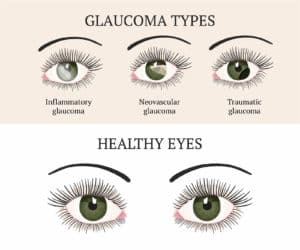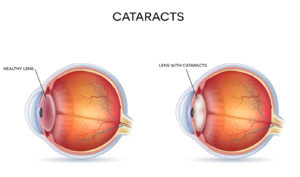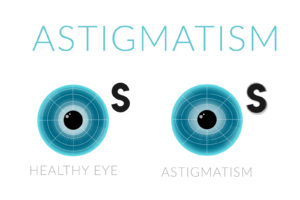
The Importance of Age-Related Eye Disease Studies
Aging is an unfortunate fact of life. While growing older brings many benefits like increased wisdom and experiences, it also causes your body to change, your abilities to decrease, and your mind to slow down. Your eyes are no exception; there are many age-related eye diseases that everyone is at risk for. People over the age of 50 are especially vulnerable, which is why regular exams are so important. Thanks to the age-related eye disease studies that have paved the way for current and future research, we know which nutrients our eyes depend on. Here’s everything you need to know about these diseases and these studies.
Age-Related Macular Degeneration (AMD)
AMD is a leading cause of vision loss in America and typically develops after 50. The macula is a tiny part of the eye’s retina. It’s responsible for producing your central field of vision, crucial for driving, reading, and seeing the details in your view. AMD causes the macula to degenerate, which causes you to lose your central field of vision. Although you don’t lose your entire vision, losing your central field is enough to impair your eyes and affect your activities.
There are two causes of degeneration in the macula, drusen (yellow deposits of lipids) under the retina or new blood vessel growth under the retina. In the former, the drusen comes from natural waste deposits from the retina. If they aren’t flushed out naturally, they cause a blockage and prevent nutrients from getting into the retina. It’s also called “dry” AMD and is generally slow to develop. In the latter, “wet” AMD, lots of tiny blood vessels start growing under the retina and subsequently bursting. The leaks in these vessels can cause you to lose your vision faster than in dry AMD.
AMD was one of the main diseases the age-related eye disease studies wanted to focus on. Far too many Americans are suffering from a loss of vision due to it. The more you know about conditions like AMD, the more able you will be to prevent such diseases from happening in your or a loved one’s life. This is why it’s important to stay up to date on such research.
Cataracts
Cataracts, another age-related eye disease, affects over 25 million Americans. You may already have an idea of what cataracts are in the eyes. Those suffering from them often have “cloudy” eyes, or their eyes have a grey tint. The cause is that the proteins in the eye’s lens form clumps. As the clumps collect more proteins, they get bigger and eventually block your vision.
When cataracts are caused by age, they usually begin to develop between 40 and 60 years old. Globally, cataracts are the cause of over half of the world’s blindness. You may first notice that colors appear faded or less vibrant. Your vision could become cloudy, or doubled, or you may see halos around lights. Since this disease affects so many people worldwide, scientists made it a priority along with AMD in age-related eye disease studies.
Age-Related Eye Disease Study (AREDS)
 The first of these two monumental studies was published in 2001 and sponsored by the National Eye Institute. At the time, AMD and cataracts were already well-known age-related diseases. The researchers wanted to learn more about the risk factors of these diseases, as well as how specific supplements would affect their progression.
The first of these two monumental studies was published in 2001 and sponsored by the National Eye Institute. At the time, AMD and cataracts were already well-known age-related diseases. The researchers wanted to learn more about the risk factors of these diseases, as well as how specific supplements would affect their progression.
The AREDS study was based on 3640 participants between 1992 and 2001. Following each participant for an average of 6.3 years, they had some major breakthroughs.
Each participant consumed a supplement formulation of vitamin C, vitamin E, beta-carotene, zinc, and copper. The results? This combination of antioxidants and zinc could reduce some people’s risk of developing advanced AMD by 25 percent. However, the formulation had no effect on the participants’ risks of developing cataracts.
AREDS 2
From 2006 until 2011, researchers did a follow-up study called AREDS 2. The goal was to build on the results of AREDS by adding subsequent nutrients. There were questions regarding the effectiveness of omega-3s and lutein and zeaxanthin in reducing the risk of age-related diseases.
The participants took one of four possible formulations. The first was the original AREDS formulation, the second was the AREDS formulation without beta-carotene, the third was the AREDS formulation with decreased zinc, and the fourth was the AREDS formulation without beta-carotene and with low zinc levels. In addition, one in four formulations had omega-3s, lutein and zeaxanthin, omega-3s and lutein and zeaxanthin, or a placebo.
The results of AREDS 2? Researchers found that simply adding lutein and zeaxanthin to the AREDS formulation didn’t affect the risk of developing AMD. However, participants who took the formulation containing lutein and zeaxanthin, but no beta-carotene, saw a reduction in their risk of developing advanced AMD. Additionally, participants who were already low in nutrients lutein and zeaxanthin benefited from taking the formulation and had a decreased risk of developing AMD as well as cataracts.
What Do These Studies Mean for Me?
These ground-breaking studies informed physicians, scientists, and patients on how late-stage AMD and cataracts can be prevented. Although your risk of early-stage AMD can’t be decreased (yet), you can slow down the progression of onset AMD and cataracts.
You can get the AREDS and AREDS 2 nutrients from your diet, but the National Eye Institute suggests taking a full supplement to get the exact doses used in the study. However, some people should avoid taking supplements that contain beta-carotene. Studies have shown that taking beta-carotene can increase your risk of lung cancer if you currently smoke or have recently quit.
Overall, the age-related eye disease studies show us the power of getting all the important eye nutrients daily. When the body is deficient in certain nutrients, especially lutein and zeaxanthin, your chances of developing an age-related eye disease go up. Whether you can achieve that through your diet or need to take a supplement, the benefits are notable. The Ocu-Plus Formula contains 17 essential eye vitamins, including the AREDS and AREDS 2 nutrients (except for beta-carotene). This is an excellent option for those who are at risk of developing age-related eye diseases and want to keep their vision healthy for as long as possible.
Our Rebuild Your Vision Ocu-Plus Formula Contains All 17 Vitamins, Minerals, and Herbal Supplements to Improve Your Eye Health!












Leave Your Reply